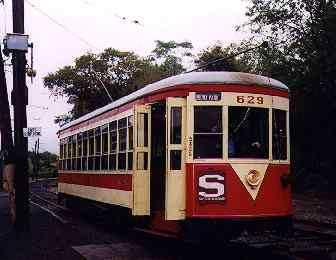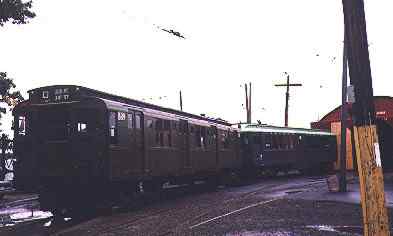Although the trolleys of New York City are no more, many of the cars that appeared on city streets until the mid-1950s can be found at the Shoreline Trolley Museum in East Haven, Connecticut.
In 1945, several electric railway enthusiasts realized that trolleys were on the way out, being replaced by buses as the prime method of urban mass transit. They decided to find a place whre a variety of trolley cars could be preserved, exhibited and operated for the public.
Around the same time, the Connecticut Company’s trolley line from East Haven to Branford was in the process of shutting down. When it ceased operations in 1947 it was turned over — track, trestles, and overhead wire — to the nascent Branford Electric Railway Association.
The trolley museum has grown steadily from 27 trolleys in 1950 to the present day collection which boasts over 90 cars. Horsecars, trolleys and subway cars are all represented. There’s a repair shop on site which keeps the cars in perfect running condition.
Normally associated with San Francisco, cable cars, drawn by an underground wire, also made inroads in New York City.
This was originally a cable car built by the Laclede Company, and operated on the main cable car line on Third Avenue beginning in 1892. It was converted to electric power in 1899 when the existing cable wire was given electric conductors. It was retired from passenger service in 1908 and was used to remove ice and snow from the cable conduit slot until 1948, when it was donated to the Museum.
This car was one of the last of NYC’s trolley cars to be built in America. It was built in the Third Avenue shops located at Third and 65th Street in Manhattan in 1939.
In 1949, when the Third Avenue trolley line was eliminated, it was sent to Vienna, Austria as part of the Marshall Plan. It was presented to the Museum by the City Of Vienna in 1967.
The interior of a typical streetcar (ca. 1915) featured reversible seating. Wicker seats (used on subway cars at the same time) could be pulled by a lever to reverse the seat direction when the trolley reached the end of the line so that passengers could face forward.
This car was one of the first PCC cars to make its appearance. PCC’s, or “President’s Conference Committee” cars were produced in response to a drop in trolley ridership in the 30s. The rise of the automobile, as well as the Depression, had taken a toll on the trolleys. Riders also objected to the noise, slowness and uncomfortability of trolleys.
PCCs, which started production in 1936 by the St. Louis Car Company, addressed the problems with new braking systems, improved lighting and seating, and rubber inserts in wheels and springs to reduce noise.
Even now, the PCC’s innovations can be seen in cities that presently use trolley cars.
#1001 ran in Brooklyn.
Subway cars are also featured at Shoreline. These cars were on the IND lines from the late Forties through 1977.
1/10/1999







2 comments
It should be noted that the first photo on the page is one of the sister cars to #629 from the Third Ave Railway that went to Vienna. When 629 arrived at the museum it had its Vienna #4239 and paint job for a number of years before it was repainted to its Third Ave colors. Also it is about three years newer than the PCC #1001.
Hi , I am interested to go and would like know when you will have the holiday decoration in the train. In the city or queens.
thank you